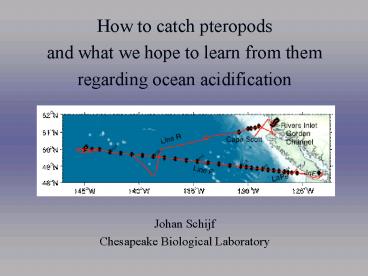How to catch pteropods - PowerPoint PPT Presentation
1 / 32
Title: How to catch pteropods
1
How to catch pteropods and what we hope to learn
from them regarding ocean acidification Joha
n Schijf Chesapeake Biological Laboratory
2
The crew
Vicky Fabry (CSUSM) zooplankton expert talks to
congress
Bob Byrne (USF) pH expert
Andrew Dickson (Scripps/UCSD) alkalinity expert
Johan Schijf (CBL) does not get seasick can
operate a screwdriver
3
Ocean acidification for dummies (the other CO2
problem)
CO2
4
Eastern Pacific (2006)
R/V Thomas G. Thompson (274 ft) US
Navy/University of Washington
5
(No Transcript)
6
CO2 dissolution is promoted by low water
temperatures which also cause rapid advection
from surface to deep water
7
The net effect of the extra CO2 is to add more
protons to the water (acidification) and to lower
the saturation state W Most calcifiers seem to
require a minimum saturation state of W 4
8
Pure calcium carbonate comes in three common
polymorphs aragonite (more soluble), calcite,
and vaterite (non-biogenic) Laboratory
experiments have found an empirical relation
between the CaCO3 dissolution rate R dCa2/dt
and W R(W) k(1 W)n
9
aragonite
10
- Advantages of pteropods
- Shell is aragonite (more soluble)
- Macroscopic in size
- Abundant
- Tissue easily separated from shell
11
The bugs
Our star players Clio
pyramidata Limacina helicina both make
glass-like, perfectly transparent aragonite shells
12
Clione limacina (sea angel) gymnosome
pteropod voracious predator of other
pteropods useless, because shell-less, but we
enlist its services for our own evil purpose
13
Clio balantium (a giant among pteropods) not
useful, because impossible to remove from its
shell
14
- Our research questions
- Does the relation between the CaCO3 dissolution
rate and saturation state also hold for fresh
biogenic CaCO3? - Is the relation different for aragonite and
calcite? - Is it different for different pteropod species?
(shape effect? matrix effect?)
15
- The experimental approach
- Collect seawater, determine W
- Collect bare pteropod shell (remove tissue and
poison seawater with HgCl2) - Place shell in seawater and maintain W by
reproducing ambient P and T - Determine to find R(W), using
spectrophotometric pH measurements
16
How to catch a pteropod?
? plankton net (horizontal tow) ? bongo net
(vertical cast)
17
The catch is in! (pictures do not capture smell)
if only we caught just pteropods
Neocalanus cristatus calanoid copepod
18
finally, after 4 hours of sorting through
bouillabaisse
a handful of Clio, who are then cruelly yanked
out of their shells
19
The spectrophotometric cell (30 mL) must be
optically ideal, must be able to reproduce
ambient temperature (fogging!) and pressure, and
must be continuously stirred without interfering
with the optical path
2007 design (Center for Ocean Technology)
20
2008 design (SRI, Inc.)
21
setup in the Tully temperature-controlled lab
22
cell close-up from above
23
cell close-up from side
24
Temperature and pressure (2-25C 0-1500 psi)
25
The preliminary results (lines indicate general
trends for typical samples actual data have been
removed)
26
New project incorporation of Yttrium and the
Rare Earth Elements (YREEs) into pteropod
aragonite
27
This figure from Tesoriero and Pankow (1996)
shows that the distribution coefficient D for Sr
depends on the calcite precipitation rate, log R.
Qu et al. (unpublished data) have recently shown
that similar graphs for the YREEs have a negative
slope for calcite, but a positive slope for
aragonite
28
Qu et al. model Aragonite (9-coordinate)
preferentially takes up Calcite (6-coordinate)
preferentially takes up
29
Because the incorporation of YREEs into calcite
and aragonite is likely to be strongly pH
dependent, YREE fractionation in pteropod
aragonite may be an ocean acidification proxy
30
Preliminary study of YREE carbonate precipitation
31
Advanced Photon Source (APS) electron
synchrotron Argonne National Laboratory (Argonne,
IL)
EXAFS techniques will be used here to study the
coordination of YREE ions in the aragonite lattice
32
Acknowledgements Two excellent Tully crews Marie
Robert and IOS for help and hospitality National
Science Foundation for (lots of) funding Jackie
Takacs for help with the cruise blog Tansey Hall,
Anissa Merzouk, and Helen Shevchuk for musical
bingo support at Charles Dickens pub

